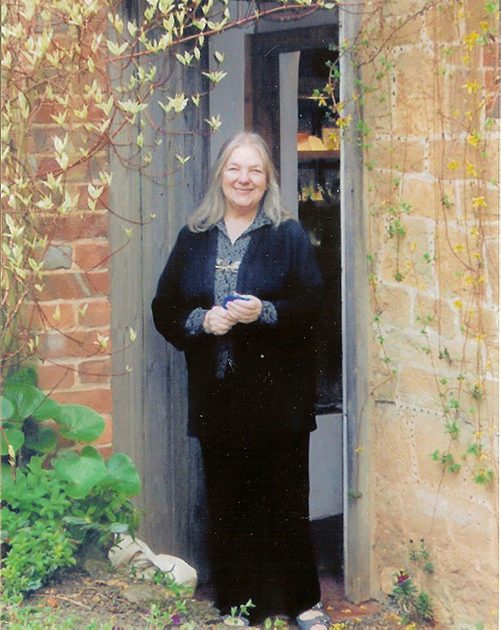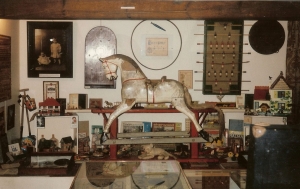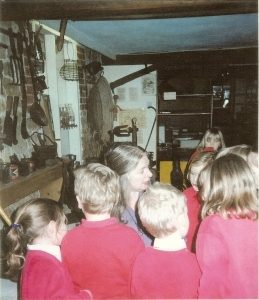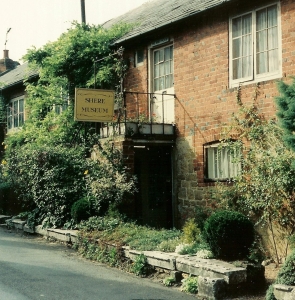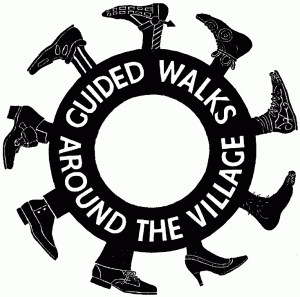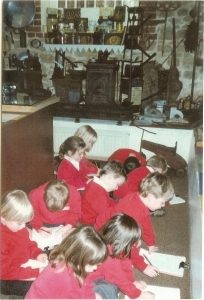Elizabeth Rich – The creator of the original Shere Museum located at The Malt House on Shere Lane from 1984 to 2007.
The Original Shere Museum (1984-2007)
This is a story of a series of fortunate events mixed with one person’s passion for history and a love for their village.
Elizabeth Rich was born in Shere, attended the village school, girl guides, church choir, etc – and grew up at Yew Trees in Shere Lane. At age 16, she was looking out her window, when she saw a young man in the window opposite.
John Rich, a young artist, was renting a studio in The Malt House at the time. From this first meeting of eyes across Shere Lane, the two soon fell in love and went on for the next 60 years.
In the years that followed, Elizabeth and John ventured away from Shere, to live in Paris. There, John pursued his career and Elizabeth became chief-earner by professional modelling. The pair later returned to live in southern England, and had five sons.
They always dreamt of returning to the village and, when they revisited in the late 1970s, John’s former landlord, Harold Colebrook, still lived at The Malt House and offered to sell it to them. They, of course, jumped at the chance and returned to live in Shere by 1980.
It wasn’t long before she was helping to preserve the village’s past. In 1981, she responded to an advert in the Parish magazine from the Local History Society (LHS), who were requesting space to store their archives.
The couple had already discovered that the ground floor of The Malt House was full of assorted ‘treasures’ left behind by previous residents. Some items even dated back to Reffell’s, when the building served as a maltings for the brewery in Gomshall.
They provided the space and Elizabeth joined the LHS committee.
Clearing the space was a challenge. Being open to the elements, much had rotted and things randomly dumped meant that stacks of china and glass were shattered. However, the range of suitable items was amazing.
Once an industrial building, The Malt House had a large basement, half underground with an earthen floor and bars at the glass-less windows. Only the malting floor had been converted in the 1920s. The basement had been used for storage and later as an air raid shelter.
The Local History Society’s archives combined with the intriguing items already in the building made for a large and unique collection.
In 1984, she carefully arranged the collection and opened-up for village’s annual “Fair in the Square”, expecting it to be a one-off. However, the event was a great success, with 360 people visiting the fledgling museum in a single afternoon! The LHS committee had the pleasure of reading all of the wonderful remarks in the Visitor’s Book.
Elizabeth invited the LHS to take it on permanently but they declined and when people began to donate things, she realised it was a new responsibility and she must endeavour to deserve their trust.
With local people repeatedly asking when it was next open, Elizabeth decided to do it again. The new Shere Museum opened its doors for a nominal 20p per adult and 10p per child – but free to Shere Parish residents.
She continued to care for a growing collection of local artefacts and archives. From this, she created and curated a charming village museum, bursting with character, and making memories for all who visited. It also developed an enviable reputation in official museum circles for its appeal and meticulous preservation of objects.
To attain a professional approach, she studied archive methods and the interpretation of ancient documents at Denham College and recording the past at the Bodleian at Oxford. She had also gained valuable experience in conservation of parchment and paper whilst working at Church House in Westminster and as a volunteer at Dorking Museum.
Colleagues at the Surrey Museums Group shared their knowledge and gave valuable support. She visited other Surrey museums for ideas and advice and especially having her children’s views on how to make a museum combine learning with fun. But she learned most from the visitors who shared their knowledge and memories with her.
Under Elizabeth’s direction, the original Shere Museum was open nearly every day of each year.
The toys and games section of the original Shere Museum
Elizabeth with children from Shere School at the museum
In time, over 40 regular schools brought nearly 1000 students annualy. Often, when schools visited, the teacher outside would tell the children “not to run about, not to be noisy, not to touch anything, etc.” and they would come in looking sulky and expecting to be bored. So Elizabeth made sure that they went away smiling! One even wrote in the Visitor’s Book “Better than the British Museum”!
At first, the thinking was everything should have a label but it began to look like a snowstorm. It was noticed that visitors tended to glance from label to label and hardly looked at the items, whereas, with fewer labels, people stopped, looked, discussed “What is it?” “Who would use it?” etc. So, Elizabeth removed most labels and provided clues instead – such as local trade receipts, old advertisements etc. and people began to get a feeling of the reality of living in the past.
Over the years, the museum hosted various club meetings, events, launches, treasure hunts and Elizabeth had consultations with television producers who filmed at the museum and in the village.
Dozens of exhibitions were curated, including displays for special historical anniversaries, archaeological societies, the Church, Women’s Institute, Red Cross and more – and not just at the museum but also at other venues in the area.
The Vintage Radio exhibition was the most popular display. People could experiment with the ‘cat’s whiskers’ and Morse code and listen to the popular music of the 20s and 30s.
Some displays resulted in happy reunions. For example, an exhibition about the Barn Theatre brought together actors who had not met since the 1930s. Incidentally, Peter Ustinov made his debut here aged 17 and Dirk Bogarde was sometimes in the audience.
The biggest reunion organised in this period was the 150th anniversary of Shere School, when about 250 ex-pupils came including former evacuees.
Elizabeth provided local history information for numerous books and publications and props for theatre groups, including the Yvonne Arnaud Theatre.
She took hundreds of visitors on guided walks around the village and enjoyed interacting with people about the village’s rich history.
The original Shere Museum flourished under Elizabeth’s direction from 1984 to 2007, before she decided to donate the entire collection to the parish. It was first offered to the parish in 1996 when the former Working Men’s Club became available. Overall, it took nine years to achieve.
At that time, she was delighted to be able to pass it on, expecting the collection to be cared for and enjoyed long into the future, building on the great success of the original museum at The Malt House.
Her hope was, with the new location being more central and with more people involved, that it would be open and visited even more than it was before.
Having set it up in the new venue she was made redundant and has since had no role there – apart from nominally being a Trustee.
She has now lived in the village for 60 years and knowing so much local history is a valuable resource for those who wish to know more. She has helped with more than eighty genealogy enquires so far!
If you need help with a local family history, please reach her via the Contacts page of this website.
Thank you for reading about the history of Shere Museum!
The Original Shere Museum at The Malt House in Shere Lane.
Currently the building is a Pop-Up Gallery, open many weekends each year – showing the work of Elizabeth’s late husband, artist John Rich.
To see the artworks and read his story, please visit:
The ‘logo’ designed by members of the Rich family, to promote the Guided Walks of the village that Elizabeth frequently provided for visitors to the museum and the village.
Children drawing objects at Shere Museum. Thousands of school children visited the original museum over the years.

